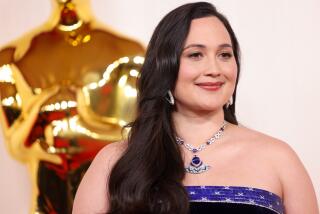Women still a rarity in top film jobs
A woman is more likely to hold a seat on a Fortune 500 company board (15%), serve as a member of the clergy (15%) or work as an aerospace engineer (10%) than she is to direct a Hollywood movie (7%).
A year after Kathryn Bigelow became the first woman to win an Oscar for best director for “The Hurt Locker,” a new study indicates that the share of top behind-the-scenes positions held by women in Hollywood remains stagnant at low levels.
Women held 16% of key jobs such as director and producer on the top 250 films of 2010 (as measured by domestic box-office receipts), according to the Center for the Study of Women in Television and Film at San Diego State University. That’s steady from the 2009 figures and about the same level as in 1998, when the center launched its “Celluloid Ceiling” report.
“People were talking about the Bigelow effect, and would her success open the door for other women,” said Martha Lauzen, executive director of the center. “It affected her career, but we’re not at that point where there’s a halo effect that reaches out to other women.”
In 2010, women were most likely to work in the romantic comedy, documentary and romantic drama genres, and least likely to work in the horror, action and comedy genres, according to the study.
One reason that the number of women working in film hasn’t increased more quickly may be the fee-for-hire system used to staff movies, said Melissa Silverstein, co-founder of the Athena Film Festival, which opens Feb. 10 in New York City with the theme of celebrating women’s leadership in film.
“Directors, writers — they’re technically not employees of the movie studios,” said Silverstein. “So the studios keep no statistics, except of course for counting box office.” And without statistics, there’s no urgency to change, Silverstein said.
“If this were a Fortune 500 company and they looked at these statistics, they would have a diversity committee working on this immediately,” she said. “How could you have a company in the 21st century and less than 10% of its leaders are women?”
The film category where women are scarcest is cinematography; women shot just 2% of films in the study. “We used to think it would get a lot easier for women,” said Nancy Schreiber, who shot the recently released Helen Hunt and Liev Schreiber movie “Every Day.” “But things are changing much more slowly than I ever anticipated.”
Being a rarity, Schreiber said, adds extra stress to an already pressured career path. “As a cinematographer, you’re running the set, the camera, grip, electrical departments. We cannot make mistakes, ‘cause it reflects on every other woman.”
Women’s under-representation on film sets has implications beyond the vocational, according to Lauzen.
“I don’t think people know when they walk into a theater that nine out of 10 times they’ll see a film by a male director,” Lauzen said. “It’s not just an employment issue for women, it’s a cultural one for all of us. Movies make a difference in how we see the world and how we see certain groups of people. These are the architects of our culture.”
More to Read
The biggest entertainment stories
Get our big stories about Hollywood, film, television, music, arts, culture and more right in your inbox as soon as they publish.
You may occasionally receive promotional content from the Los Angeles Times.











